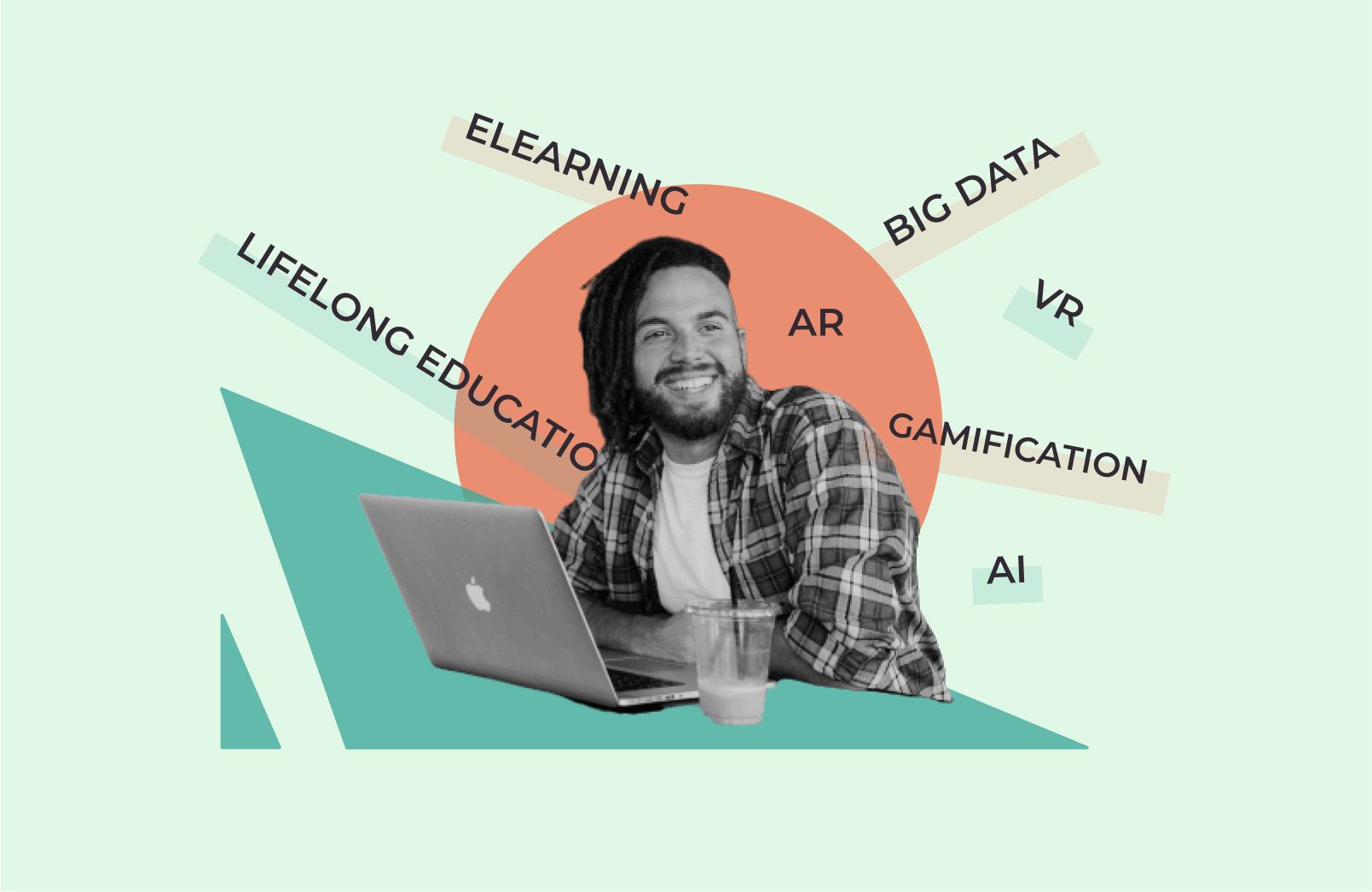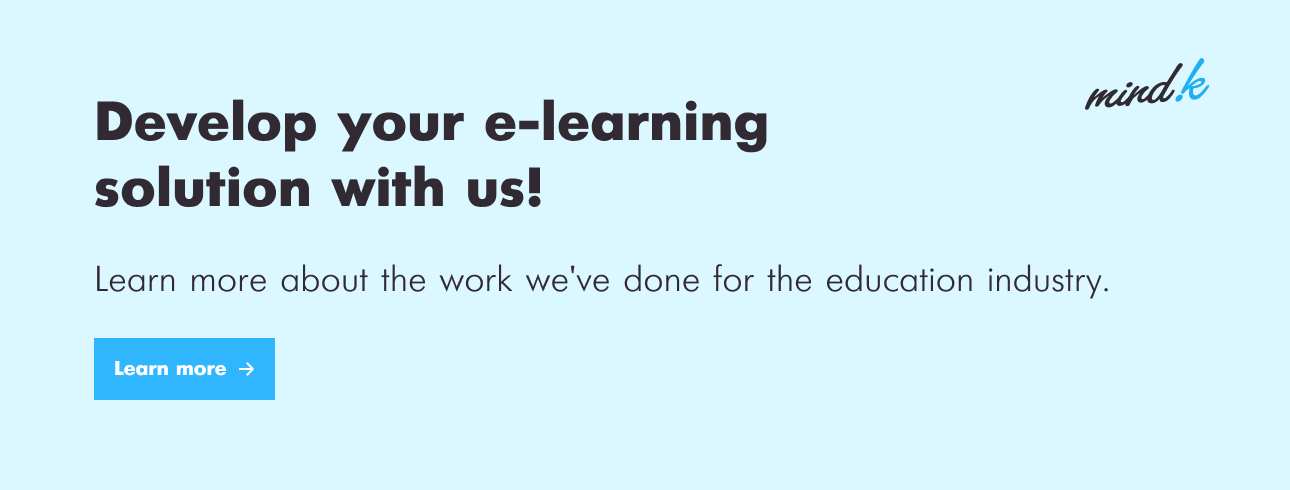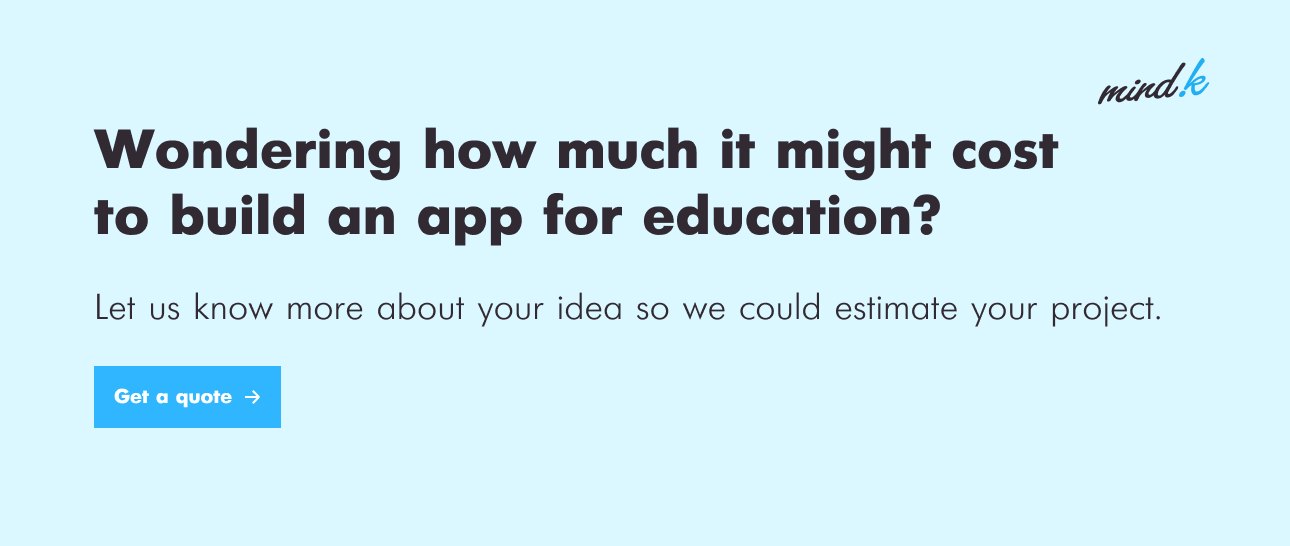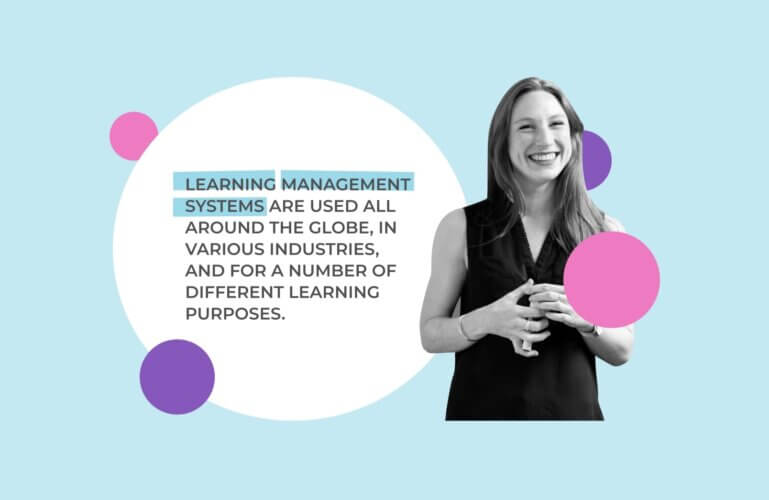Education is one of the most traditional industries, and it is changing before our very eyes. The learning process now includes online classes, learning management systems, and mobile apps to make education more effective and accessible.
Our latest global EdTech landscape analysis shows that this tendency continues to evolve. The pandemic caused an extreme growth in demand for educational technology tools of all kinds. This sets the pace in the EdTech industry for many years to come.
But how will modern technologies change the way of teaching in the near future? This is what we are going to find out.
If you want to become an innovative educator, understanding trends in educational technology is a must-have. It will help you build a strong competitive advantage and reach or better the desired return on investment.
At MindK we help companies create modern custom EdTech solutions. Based on the experience gained from our clients and in-depth market analysis, we’ve identified a list of the modern trends in educational technology you should definitely consider embracing sooner rather than later.
What EdTech market trends will fuel the future of education?
Trend #1. Lifelong education
Lifelong education involves any learning activity conducted after formal, traditional education (school and college) is over. It refers to anything you learn while employed, retired, or not formally working.
Many venture investors admit that lifelong learning is one of the top trends in educational technology. Today, learning doesn’t end when university does. To live and work in-step with a rapidly changing world, we need to learn new things every day. It refers to both personal and professional education.
According to Udemy report on workplace learning trends, the major goals for learning and development in the corporate sector in 2020 were:
- closing the skills gap;
- driving organizational growth;
- improving employee engagement; and
- increasing job satisfaction.
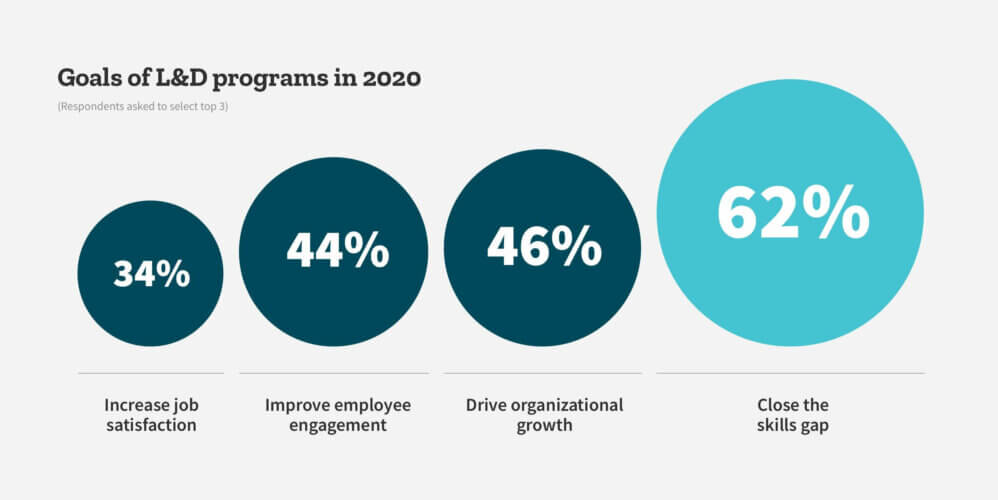
Additionally, in the next three years, around 54% of all jobs will require fundamental reskilling or upskilling. It means that demand for learning managment systems and other educational soft will continue to grow. For those who need to develop a custom learning managment system, we’ve already shared some tips on how to develop LMS within the budget.
Here are some examples of solutions that provide benefits for professional education.
Absorb LMS is a functional turnkey learning management system aimed at large businesses and training companies. It goes far beyond a typical learning experience platform and offers smart administration, deep branding capabilities, robust integrations and much more.
Talent Litmus, is focused on apps for Human Resources. Their games are contextualized to company needs and fit into any hiring, learning, or other HR initiatives.
The key takeaway is that continuity of education is the background for future education technology. Those EdTech companies that find a way to continuously provide people with high-quality, up-to-date knowledge – visually, quickly, and online – will hit the jackpot.
Trend #2. Massive transition to eLearning
In 2021, there’s probably no bigger EdTech trend than e-Learning.
E-learning is very scalable and allows educators to reach many students at the same time or, in case of on-demand pre-recorded courses, at different times. It is much more affordable and accessible than traditional face-to-face classes. It is a small wonder why this industry is expected to reach $375 billion by 2026.
E-learning is often confused with distance learning. Even though they have much in common, they are still not synonymous.
Distance learning presupposes that teachers and students are separated by distance. E-learning, in turn, is not necessarily delivered at a distance but involves using electronic educational materials carried out by means of digital technologies (smartphone, VR simulator, etc.).
Also, recently, among the e learning trends, e-learning 2.0 (e-learning based on Web 2.0 technology, when content is created by users themselves through blogs, wiki, podcasts and social networks) and m-learning (learning using mobile devices) are gaining increased popularity.
Let’s consider some e-learning solutions that are often used by educational institutions, as well as by companies for training employees:
- E-learning courses that represent a complete and structured educational material. It should include learning objectives, related content and final assessment. They are quite popular due to low cost, ease of development and high teaching efficiency.
- Video conferencing and tutorials that presuppose telecommunications between a group of people. In the case of video conferences, all participants see and hear each other. During video lessons, the participants hear only one lecturer, yet he, at the same time, sees and hears all students.
- Online simulators that enable students and professionals around the globe to sharpen their practical skills. It is a great example of an effective use of technology in education since it involves no stress, therefore, students are not afraid to break expensive equipment, blow up a plant when pumping oil products, or kill people while piloting an airplane. Despite the huge advantages, simulators are rarely used because of their high cost. Few organizations have the resources to purchase such training products.
It is quite obvious that e-learning is not a temporary trend, but a modern approach to the organization of the educational process. In the future, the interest in online learning will increase, and the development of digital technologies will trigger new innovations in educational technology.
The MindK team also didn’t stand aside from the e-learning trend. We have our long-term partner for whom we created a feature-rich cloud-based solution tailored specifically to the current demand for online workshops and virtual conferences. It reduced the problems in using different platforms for education and helped our client to boost company success when the whole education industry has shifted to e-learning.
Trend #3. Immersive learning with VR and AR
Immersive learning with Virtual Reality (VR) and Augmented Reality (AR) belong to emerging technologies in education. They are devoted to making education more engaging by changing the role of the student. The student turns from passive observer to an active participant who can interact with the learning environment.
Edtech now uses VR and AR to attract students’ interest in various fields.
For example, instead of studying London from a schoolbook, isn’t it better to make a virtual tour to London? Google Expeditions, now part of Google Arts & Culture, makes it possible to take a number of VR excursions from the Louvre to Everest.
This new technology in education is also applied in corporate training. British startup VirtualSpeech helps develop soft skills and simulates many professional situations – for example, negotiating with a “difficult” client or performing on stage in front of a huge audience.
Education is expected to be the fourth largest sector that will invest in virtual reality. VR in education is predicted to become a $700 million industry by 2025.
So, there is no better time to consider an immersive strategy for your education business.
Trend #4. AI-enabled approach to education
Artificial intelligence (AI) is the brilliant example of effective use of information technology in education. Analysts predict a dramatic increase in spending on (AI) in education to $6 billion during the next five years.
Being an innovation in education technology AI covers a wide range of solutions. Here are some of them:
- Interactive interfaces that help involve students in the learning process and receive feedback from the system in a short time frame. Generation Z (born between 1995 and 2010), in particular, usually sets a high value on interactivity when choosing an online course.
- Voice assistants such as Amazon Alexa, Google Home, Apple Siri, and Microsoft Cortana can be used in teaching instead of traditional hard-copy materials or websites. For example, Arizona State University uses Alexa to answer the questions of first-year students.
- Personalization allows focusing on the needs of a particular student. AI enables to develop an individual learning profile and adapt learning materials for each student, depending on their abilities. For example, around 700 Belgian schools have introduced the British teaching AI platform Century Tech into their learning process. The system analyzes the interests of students, their learning curves and knowledge gaps. Based on the data collected, it creates an individual learning program.
- Assessment tools that automatically help evaluate work and give feedback. This way, teachers spend less time on routine tasks and students receive instant results and comments.
- Chatbots which can be used for almost any educational purpose from the admission of students and assessing the learning results to being a fully-featured teaching assistant. Great examples are chatbots like Ivy.ai, as well as AdmitHub, which are administrative assistants and help with anything from admissions to housing and financial aid.
Our company also wanted to make a contribution to AI-powered education. That is why MindK built a WannaBe.Guru chatbot, an A.I. tutor that helps students study web development from the ground up. It allows students to choose the category they are interested in and answer both theoretical and practical questions in the form of quizzes.
Evidently there are a great number of AI-based solutions, however, the most promising direction of using AI in education is creation of complex automation systems that enble control of the whole educational process.
Trend #5. Subscription-based learning
Some years ago, learning based on subscription was a doubtful method of education. Today it is increasingly widespread and accepted.
Traditional online learning presupposes you purchase a course, view it, fulfill tasks and, if available, receive feedback and a certificate confirming the completion of the training.
But this method has a core problem. Each time you buy a course, there is a possibility that part way through, you understand that the training is unsuitable or unattractive to you.
Has this ever happened to you? In that case, very often you cannot receive a refund.
Subscriptions solve this problem.
The subscription gives you full access to all the materials of the course or various courses. It enables you to change the course at any time, stop learning, return to previous lessons, go to the next lesson, etc. You can study whatever you like at a comfortable pace without overpaying for the number of courses you complete.
Subscription is a very promising business model. It is a great instrument to turn online training for your customers into a habit. This way you have a good chance to convert a one-time purchaser into a regular customer.
A great example is Masterclass, a streaming platform with education courses for everything that matters. The annual subscription provides unlimited access to all classes and new classes as they launch.
Trend #6. Gamification and game-based learning
Gamification, as well as immersive learning, represent a favourable use of technology in education, as they engage students in the process. This method is not new (it has been used for about 20 years). Today’s online learning solutions are using it with full force because it is extremely actionable.
What is the secret of its success? Quite simply: studying is always difficult, while playing is easy and interesting.
Most people think gamification is the game approach only. In fact, gamification includes a great variety of tools that can improve user experience.
If you decide to introduce gamification in your learning solution, you should try to:
- make the learning process as clear as possible: the student should clearly understand the rules, have life-like cases and well-defined goals.
- forget about stereotypes: quite often the creators of digital solutions or courses are afraid to use gamification as they think that children will be skeptical about it, adults value their time and do not want to play, and there is absolutely no way old folk will like it. It’s not true. Practice shows that gamification engages people regardless of age, language, or religion.
- apply different motivations: most gamification tools relate to external motivation like achievements and ratings. This motivation is powerful, but short-term. Therefore, you should also use internal or self-motivation. The user should form the goals and understand that he is the one who is responsible for the result.
- try things out: don’t be afraid to try different approaches and test various formats. Moving in the groove is easy, but it may be boring for the students.
Duolingo, for instance, helps people of all ages learn English in an easy and interactive way. Users can offer a challenge to a friend and earn Lingots, the in-game currency.
Most innovators move further and use games to reach learning goals.
The best confirmation of this fact is the project “Minecraft: Education Edition“. A popular computer game loved by millions of children is successfully used for educational purposes. The magic of this tool is that it can be adapted to any subject like architecture, geography, English, biology, culture, physics, chemistry, etc.
Gamification combines two important factors. Firstly, children get a familiar and interesting environment, so there is no need to spend time and energy on holding their attention. Secondly, the flexibility of the tool allows you to submit almost any educational information in a playful way. It is limited by your imagination only.
Trend #7. Big Data for improved analytics
Big Data is not the latest technology used in education but will deserve special attention in the foreseeable future.
Digital learning services generate a large amount of data about student behavior, interests, interactions with content, etc. This data can be analyzed in order to receive valuable information which will improve the whole educational process or its certain parts.
The application potential of Big Data in the education industry is gigantic. Here are only a few examples of analytics through the lens of learning process:

- Descriptive analytics. It is focused on using all of the available data to make the most accurate description of the current situation. The results are usually visualized through graphs, charts, infographics, etc. The major goal is turning large data volumes into accessible and easily perceived information.
For example, Nottingham Trent University introduced an interactive system for descriptive analytics of student results in the form of a dashboard that showed data on student engagement. Three years after, 72% of students said that using the dashboard had inspired them to spend more time studying.
- Predictive analytics. Its main task is to predict events based on the data comparison. For example, the CareerChoice GPS program conducts predictive analysis to help students choose their career. The service studies the student’s character, learning performance, and previous work experience.
Right now MindK is developing a similar platform – an analytical tool for meaningful career choices. The system performs a sophisticated mapping of persons’ values, interests, and preferences to define self-insight, aiming to find a life-work balance.
- Prescriptive analytics. Each student has a unique data trail during his learning time. It is very helpful to analyze this data to understand gaps in the knowledge and help reach the pinnacle of academic achievement. Such an analysis is a must-have in order to improve the students’ learning curve.
For instance, Apex Learning creates digital learning solutions that help students track their progress throughout the semester. Teachers have access to real-time data and can use this information to adapt lesson plans to the needs of the students.
We have a great chance to observe how technology benefits education and turns it into an industry that craves constant analysis and improvement.
We at MindK believe it’s for the best. Do you agree?
Are you ready to take the next step?
There you have it – seven most interesting EdTech market trends that will disrupt education as we know it.
To sum up, you see that the impact of technology on education is huge and leads to fundamental changes in the industry. Different educational technology makes education more and more interactive, personalized and accessible.
It means that those companies that pay attention to these transformations and learn to use emerging trends in online education to benefit their projects will lead the market. Knowing the market and trends is a must to start an edtech company in 2021.
If you’re ready to get the ball rolling, MindK is ready to help your company develop up-to-date solutions for the educational industry.
